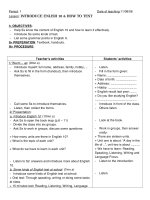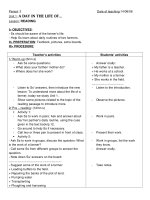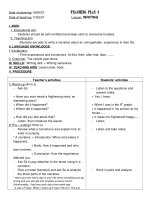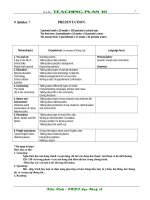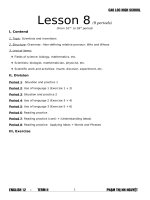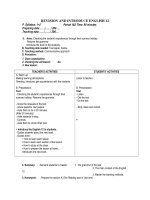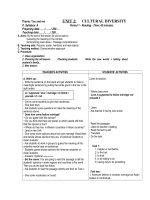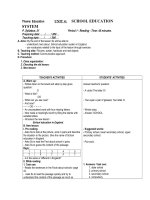E6 new teaching plan unit 2
Bạn đang xem bản rút gọn của tài liệu. Xem và tải ngay bản đầy đủ của tài liệu tại đây (272.79 KB, 15 trang )
Giáo án Tiếng Anh 6 1
UNIT 2: MY HOME
Lesson 1: Getting Started - A look inside
I. Objectives:
By the end of this lesson, students can know the key language and structures to be learnt in this
unit.
II. Language Focus:
1. Vocabulary: the lexical items related to the topic “My home”.
2. Structures:
There is / There isn’t
There are / There aren’t
Prepositions of place.
III. Method: Communicative approach
IV. Teaching ads: Course book, CD player, picture.
V. Procedures:
Teacher’s Activities
- Ask Ss to guess what the picture
might show or what the
conversation might be about.
- Ask Ss questions about the
picture.
- Ask Ss to share any recent
experiences of chatting online.
- Ask Ss to talk a bit about the
place where you live.
- Play the recording
- Ask Ss to give the answers
without reading the conversation
again.
- Ask Ss to read the conversation
and check their answers. Confirm
the correct answers.
- Have Ss work independently.
Ss’ Activities
Content
* Presentation:
- T-Whole class
Guess what the picture might show
or what the conversation might be
about.
Ex:
- What are Nick and Mi doing?
(talking on Skype; Skype = a system
that allows you to make telephone
calls using your computer and the
internet).
- Talk a bit about the place where
you live.
* Practice:
- Listen and read 1. Listen and read
- Individual work a. Which family members does Mi
talk about?
Key:
Grandparents
Dad
Mum
Brother
Uncle
Aunt
Cousin
- Individual work
b. Read the conversation again.
Not
e
Giáo án Tiếng Anh 6 2
Allow them to share answers
before discussing as class.
- Ask Ss to write the correct
answers on the board.
- Ask Ss if they know the
prepositions in the box.
- Have Ss do exercise 2 in pairs.
- Ask for Ss’ answers.
- Ask Ss to write the sentences
individually, then share the
sentences with a friend.
- Call on some Ss to write their
answer on the board.
- Check the sentences with the
whole class.
- Ask Ss to look at the picture of
the room and do exercise
individually.
- Have Ss share their answers
before giving the answer.
- Confirm the correct answers.
- Ask Ss to look at the picture and
answer the questions.
- Correct their answers
Complete the sentences.
Key:
1. TV; sofa
2. Town house
3. sitting on the sofa
4. noisy
- Pair-work
5. three
2. Match the prepositions with the
pictures.
Key:
- Individual work A. on B. next to C. behind
D. in E. in front of
F. between G. under
3. Write a sentence to describe
each picture in 2.
Key:
A. The dog is on the chair
B. The dog is next to the bowl.
C. The cat is behind the TV.
D. The cat is in the wardrobe.
E. The dog is in front of the kennel.
F. The cat is between the lamp and
- Individual work
the sofa.
G.The cat is under the table.
- Pair-work
4. Write true of false for each
sentence. Correct the false ones.
Key:
1. F (The dog is between the
bookshelf and the bed).
2. T
3. F (The clock is between the
pictures).
4. F (The cat is in front of the
kennel).
5. F (The cap is next to the pillow).
6. T
* Production:
- Pair-work
5. Look at the picture again.
Answer the questions.
Key:
1. They are on the desk.
2. They are on the floor.
3. Yes, it is.
4. No, they aren’t.
5. It’s behind the bookshelf.
6. No, it isn’t.
Giáo án Tiếng Anh 6 3
*Homework:
- Write the answer in your
notebook.
- Prepare next lesson
(A closer look 1)
UNIT 2: MY HOME
Lesson 2: A Closer Look 1
I. Objectives:
By the end of this lesson, students can pronounce correctly the sounds /z/, /s/ and /iz/ in
isolation and in context.
II. Language Focus:
1. Vocabulary: the lexical items related to the topic “My home”.
2. Structures:
There is / There isn’t
There are / There aren’t
Prepositions of place.
III. Method: Communicative approach
IV. Teaching ads: Course book, CD player, picture.
V. Procedures:
Teacher’s Activities
- Have Ss quickly match the room
with its name.
- Explain the meaning of “hall”.
- Quickly check the answers.
Ss’ Activities
Content
* Presentation:
Vocabulary
- Individual work 1. Name the rooms of the house.
kitchen
hall
bedroom
bathroom
living room
attic
Not
e
Giáo án Tiếng Anh 6 4
- Ask Ss to work in pairs to do this - Pair-work
activity.
- Write the name of the room on
the board, in different places. Call
on Ss from different pairs to go to
the board and write the name of
the furniture under these rooms.
- Ask Ss to comment.
- Play the recording.
- Ask Ss to listen and repeat the
words.
- Ask for more words for each
group.
- Model this activity with a Ss.
- Ask Ss to work in pairs.
- Call some pairs to practice in
front of the class.
- Listen and
repeat.
- Have Ss to read out the words
first.
- Play the recording for Ss to
listen and repeat the words.
- Pay attention to the sound:
/z/, /s/ and /iz/
- Ask Ss to put the words in the
correct column while they listen.
- Have Ss comment on the way to
pronounce –s/-es at the end of
the words. Quickly explain the
rules.
- T-Whole class
* Practice:
2. Name the things in each room in
1
Key:
Living
Lamp, sofa, picture,
room
table.
Bed, lamp, picture,
Bedroom
chest of drawers.
Bridge, cupboard,
Kitchen cooker, table,
dishwasher, chair.
Hall
Picture
3. Listen and repeat the words. Can
you add more words to the list.
(page 34)
- Pair-work
4. Think of a room. In pairs, ask and
answer questions to guess the room.
Example:
A: What’s in the room?
B: A sofa and a television.
A: Is it the living room?
B: Yes.
Pronunciation
/z/, /s/ and /iz/
5. Listen and repeat the words.
Lamp
posters
sinks
Fridge
tables
toilets
Beds
wardrobes
6. Listen again and put the words in
the correct column.
/z/
/s/
/iz/
Posters
Lamps
Fridges
Tables
Sinks
Wardrobes Toilets
Beds
- Final –s is pronounced /z/ after
voiced sounds (/b/, /d/, /g/, /n/,
/m/, /l/...) and any vowel sounds.
- Final –s is pronounced /s/ after
Giáo án Tiếng Anh 6 5
- Ask Ss to do this exercise
individually first then compare
their answers with a partner.
Check Ss’answers.
- Ask Ss to explain their answers.
voiceless sounds (/t/, /p/, /g/, /k/,
/f/, /θ/).
- Final –es is pronounced /iz/ after
voiced sounds (/s/, /z/, /ʃ/, /tʃ/,
/ʤ/).
- Individual work 7. Read the conversation below.
Underline the final s/es in the words
and write /z/, /s/ or /iz/.
/z/: things, pictures
/s/: lights, chopsticks
/iz/: dishes, vases
UNIT 2: MY HOME
Lesson 3: A Closer Look 2
I. Objectives:
By the end of this lesson, students can use There is/ There isn’t/ There are/ There aren’t
correctly and appropriately.
II. Language Focus:
1. Vocabulary: the lexical items related to the topic “My home”.
2. Structures:
There is / There isn’t
There are / There aren’t
III. Method: Communicative approach
IV. Teaching ads: Course book, CD player, pictures.
V. Procedures:
Teacher’s Activities
- Have Ss to play a game.
Ss’ Activities
- Group work
Content
* Warm-up:
Nought and Crosse:
cupboard
sinks
bedroom
posters
bathroo
window
m
Not
e
lamp
kitchen
wall
Ex: The cupboard is in the kitchen.
Giáo án Tiếng Anh 6 6
- Ask Ss to look at the pictures
of the two rooms in the
grammar. Ask Ss what the
second room doesn’t have.
- Ask Ss to use the There is/
There are structure to make
sentences.
- Elicit the forms (positive,
negative, questions and short
answers) from the Ss.
- Have Ss a closer look at the
grammar box, especially the
example.
- T-Whole class
- Ask Ss to do exercise 1 and 2
quickly then give the answers to
T.
- Individual work
- Have Ss to write the sentences
individually then go to the
board to write their sentences.
- Individual work
- Ask Ss to look at the picture
and complete the description.
- Confirm the correct answers
- Pair-work
* Presentation:
Grammar
There is / There isn’t
There are / There aren’t
Positive:
Singular: There’s (is) a picture on the
wall.
Plural: There are two lamps in the
room.
Negative:
Singular: There isn’t a picture on the
wall.
Plural: There aren’t two lamps in the
room.
Questions and short answer:
Singular:
- Is there a picture on the wall?
- Yes, there is. / No, there isn’t.
Plural:
- Are there two lamps in the room?
- Yes, there are. / No, there aren’t.
* Practice:
1. Write is or are.
2. Make the sentences in 1 negative.
Key:
1. is/ isn’t
2. Are/ aren’t
3. are/ aren’t
4. Is/ isn’t
5. are/ aren’t
3. Write positive and negative
sentences.
Key:
1. There is/ isn’t a TV next to/ on the
table.
2. There is/ isn’t a brown dog in the
kitchen.
3. There is/ isn’t a boy in front of the
cupboard.
4. There is/ isn’t a bath in the
bathroom.
5. There are/ aren’t lamps in the
bedroom.
4. Write is / isn’t / are / aren’t in
each blank to describe the kitchen in
Mi’s house.
Giáo án Tiếng Anh 6 7
and write them on the board.
- Have Ss do this exercise
individually, then give their
answers.
- Individual work
- Pair - work
- Model the conversation with a
Ss before Ss do this in pairs.
- Call some pairs act out he
conversation in front of the
whole group.
- Pair - work
Key:
1. is
2. is
3. are
4. are
5. aren’t
6. isn’t
5. Complete the questions.
Key:
1. Is there a fridge in your kitchen?
2. Is there a TV in your bedroom?
3. Are there four chairs in your living
room?
4. Is there a desk next to your bed?
5. Are there two sinks in your
bathroom?
6. In pairs, ask and answer the
questions in 5. Report your partner’s
answer to the class.
* Production:
7. Work in pair. Ask your partner
about his/ her room or the room he/
she likes best in the house.
*Homework:
- Prepare next lesson
(Communication)
UNIT 2: MY HOME
Lesson 4: Communication
I. Objectives:
By the end of this lesson, students can use ask about and describe houses, rooms and furniture.
II. Language Focus:
1. Vocabulary: town house, country house, villa, stilt house, apartment.
2. Structures:
There is / There isn’t
There are / There aren’t
III. Method: Communicative approach
IV. Teaching ads: Course book, CD player.
V. Procedures:
Teacher’s Activities
Ss’ Activities
Content
Not
e
Giáo án Tiếng Anh 6 8
* Presentation:
Extra vocabulary:
o Town house
o Country house
o Villa
o Stilt house
o Apartment
1. Look at the picture of Mi’s
grandparents’ house and complete
the sentences.
Key:
1. country 2. Are
3. Is
4. are
5. On
6. Next
to
* Practice:
- Have Ss look at extra
vocabulary.
- Whole class
- Ask Ss to look at the picture and
complete the sentences.
- Pair-work
- Model the way do do this
exercise with a St.
- Ask Ss in each pairs not to look
at each other’s picture and to
make similar conversations.
- Ask Ss to note down the
differences between the two
houses.
- Ask some pairs to act out the
conversation.
- Ask other pairs listen and add
more differences if there are any.
- Pair-work
- Give Ss 5 – 7 minutes to draw a
simple plan of their house.
- Have Ss work in pairs to tell
each other about their house.
- Ask Ss to note down the
differences between their
houses.
- Individual work 3. Draw a simple plan of your house.
- Pair -work
Tell your partner about your house.
2. Find the differences between the
two houses.
Example:
A: Nick lives in a country house.
Where does Mi live?
B: Mi lives in a town house.
Suggested questions:
A: How many rooms are there in
Mi’s house?
B: There are six rooms. What about
Nick’s house? How many room are
there…?
- Call on some Ss to describe their - Whole class
friend’s house to the class.
- Let Ss present the differences
between their house and their
* Production:
4. Describe your friend’s house to
the class.
Giáo án Tiếng Anh 6 9
friend’s.
- Ask Ss listen and give
comments.
*Homework:
- Write a paragraph to describe your
house in your notebook.
- Prepare next lesson : (Skill 1)
Experiments:
............................................................................................................................................................
............................................................................................................................................................
UNIT 2: MY HOME
Lesson 5: Skill 1
A room at the Crazy House Hotel, Da Lat
I. Objectives:
By the end of this lesson, students can read for specific information about rooms and houses;
describe houses, rooms and furniture.
II. Language Focus:
1. Vocabulary: the lexical items related to the topic “My home”.
2. Structures:
There is / There isn’t
There are / There aren’t
Prepositions of place.
III. Method: Communicative approach
IV. Teaching ads: Course book, CD player.
V. Procedures:
Teacher’s Activities
Ss’ Activities
Content
Not
e
Giáo án Tiếng Anh 6 10
- Ask the class to look at the
- Whole class
“Study skills –Reading”.
- Explain any words that Ss do not
know.
- Ask Ss to quickly look at the text
and answer the questions.
- Confirm the answers to
questions 1 and 2. Answers to
question 3 are open.
- Answer
- Ask Ss to quickly read the text
and check their ideas from 1.
- Ask Ss to read the text in detail
to answer the questions.
- Set a strict time limit to ensure
Ss read quickly for information.
- Have Ss compare their answer
before giving the answers.
- Ask Ss to give evidence when
giving the answers.
- Ask Ss to do exercise 4. Then
compare their answers.
- Correct their answers.
- Have each St create a new room
for the hotel and draw a plan of
the room.
- Ask Ss to show the plan to a
partner. Then ask Ss to describe
* Presentation:
Study skills – Reading
Prediction
- Predicting makes reading easy.
- Before reading, look at the picture,
design and title.
- Decide what is the topic of the
text.
- Think about what you know about
the topic.
Reading
1. Answer the questions
Key:
1. It’s an email.
2. The title is “A room at the Crazy
House Hotel, Da Lat” The topic is
Nick’s weekend at the Crazy House
* Hotel.
Practice:
3. Read the text again and answer
- Individual work the questions.
Key:
1. No, he isn’t.
2. There are ten rooms.
3. Because there’s a big tiger on the
wall.
4. It’s under the bed.
- Individual work
4. Are these things in the room?
Key:
o A window
o A lamp
o A tiger
o A chelf
o A desk
- Individual work
Speaking
5. Create a new room for the hotel.
Draw a plan of the room.
- Pair -work
* Production:
6. Show your plan to your partner
then describe the room to other Ss
Giáo án Tiếng Anh 6 11
their room in pair.
- Ask other Ss to listen and vote
for the best plan.
in the class.
*Homework:
- Prepare the next lesson: (Skill 2)
Comment:
………………………………………………………………………………………………………………………………………………………
……………………………………………………………………………………………………………………………………………………
UNIT 2: MY HOME
Lesson 6: Skill 2
I. Objectives:
By the end of this lesson, students can listen to get information about rooms and houses; write
an e-mail to a friend.
II. Language Focus:
1. Vocabulary: the lexical items related to the topic “My home”.
2. Structures:
There is / There isn’t
There are / There aren’t
Prepositions of place.
III. Method: Communicative approach
IV. Teaching ads: Course book, CD player, a large-sized piece of paper.
V. Procedures:
Teacher’s Activities
- Ask Ss to took at the plan of the
room and furniture on page 23;
Ask them to put the furniture in
the place they like.
Ss’ Activities
- Group-work
Content
* Presentation:
Look at the picture. Put the
furniture in the place you like.
The room at a hotel.
Furniture: fireplace, wardrobe,
table, bed, shelf, stool, sofa.
Not
e
Giáo án Tiếng Anh 6 12
- Play the recording. Ask Ss to
draw the furniture in the correct
place as they listen.
- Allow Ss share their answers
before listening to the recording
a final time to check.
- Correct their answer.
- Ask Ss to describe Nick’ parents’
room again.
- Ask Ss to read the Writing tips
box. Explain anything Ss do not
understand.
- Ask them several questions.
- Copy a sample of an e-mail and
show Ss each part.
- Ask Ss to look at Nick’s email on
page 22 and identify the parts in
the email.
- Check and confirm the correct
answer.
- Use this e-mail as a model to
teach the e-mail parts.
- Ask Ss to do this exercise in
pairs.
- Write the email on a large-sized
piece of paper and ask Ss to go to
the board to do this exercise.
- Correct their answers.
- Ask Ss to close their books. Tell
Ss that in this writing section,
they will follow the writing
process. Write the three letters P,
D and C on the board and ask
them to guess what these letters
stand for.
* Practice:
Listening
- Individual work 1. Listen and draw the furniture in
the correct place.
- Whole class
- Answer
Writing
An e-mail to a friend
Writing Tip – How to write an e-mail
to a friend.
- Questions:
a. How many parts are there in an email to your friend?
b. What are they?
c. What should you remember when
writing each part?
- Individual
work.
2. Read Nick’s e-mail again. Identify
the subject, greeting, introduction,
body and conclusion of the e-mail.
3. Read the e-mail below and
correct it. Write the correct version
in the provided.
- T whole class
4. Write an e-mail to Nick. Tell him
about your idea for the new room
of the Crazy House Hotel.
Giáo án Tiếng Anh 6 13
- Have Ss open their book to
check their guess. Explain the
process of writing again. Ask Ss to
look at the plan of the room they
created in the previous lesson.
- Ask Ss to write their e-mail
individually. Ask one St to write
the e-mail on the board. Other Ss
and T comment on the e-mail.
- Collect some e-mail to correct
at home.
* Production:
- Individual work Write an email to Nick
*Homework:
- Write your e-mail in your
notebook.
- Prepare next lesson :
(Looking back)
Experiments:
............................................................................................................................................................
............................................................................................................................................................
Giáo án Tiếng Anh 6 14
UNIT 2: MY HOME
Lesson 7: Looking Back
I. Objectives:
By the end of this lesson, students can review all what they have learnt in this unit.
II. Language Focus:
1. Vocabulary: the lexical items related to the topic “My home”.
2. Structures:
There is / There isn’t
There are / There aren’t
Prepositions of place.
III. Method: Communicative approach
IV. Teaching ads: Course book, CD player, pictures.
V. Procedures:
Giáo án Tiếng Anh 6 15
